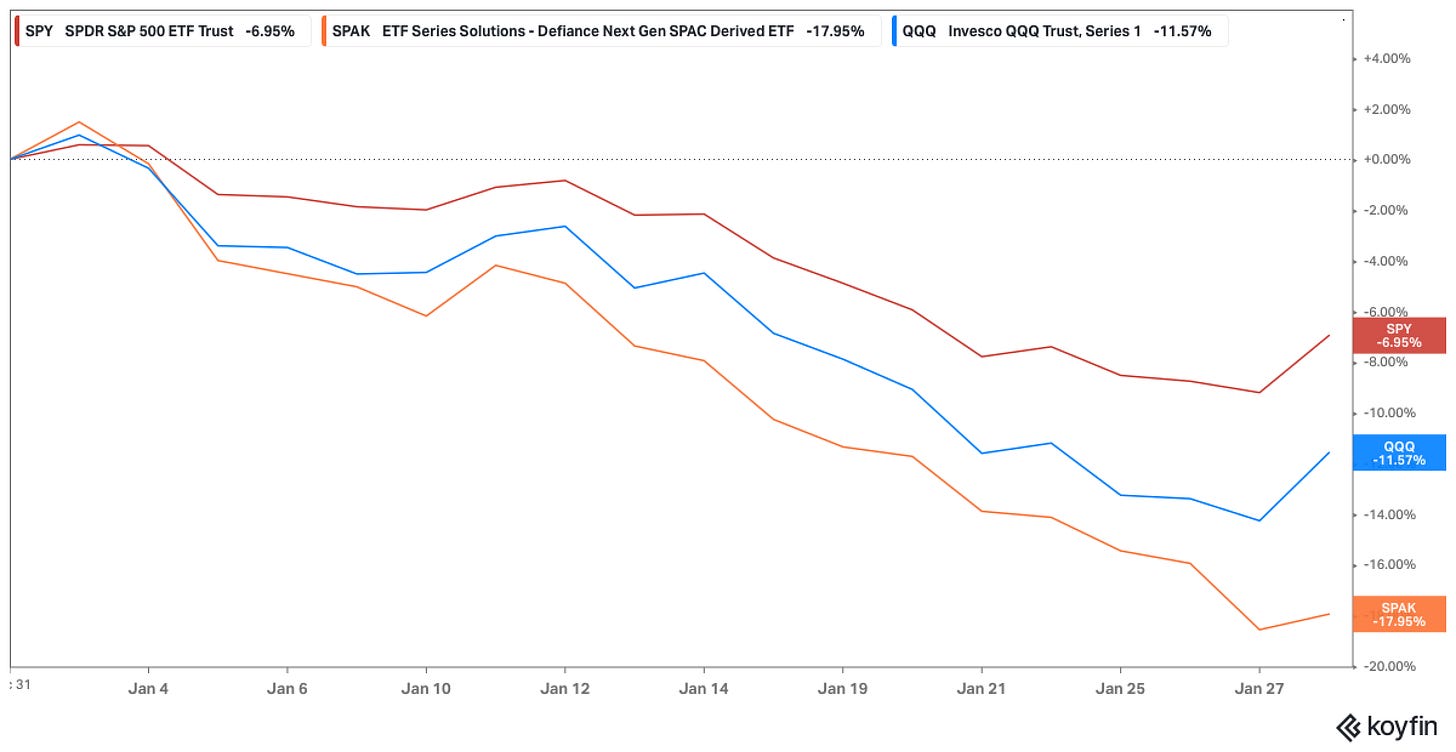Comeback Szn
Hi Everyone,
Wow, what a rip snorting weekend. I spent the last two nights pulling all-nighters to watch some of the best tennis we’ve seen in a while. First, the all Australian men’s doubles final on Friday night with Kyrgios & Kokki taking home the trophy (hot guy Kokki but not a fan of his ear ring and butterfly tattoos), and then last night (or 3 am this morning actually), the absolutely epic men’s final between Nadal and Medvedev. 5 hours and 24 minutes. Starting with Rafa being 2 sets down before he made a comeback and to then win the championship and set a record for the highest number of grand slam titles - only a Rafa could do that! And the fact that a month and a half ago, we weren’t even sure if he was going to be back on the court…Honestly, I’m just speechless. Or as Kyrgios so aptly said, “Let’s Fucking Go, Ladies!”
Yes, I am in tennis heaven today. So much so that yes, I don’t care that the SPAC ETF, $SPAK closed down another 5% this week, and is down 18% in the first month of the year.
Or that 98.5% of SPACs are trading below NAV, including all 6 of the Chamath ones. (including the $DNAA and $DNAC that announced mergers last week). Or that the average SPAC warrant fell 13% last week.
But y’all already knew that. Since every market pundit is talking about the ongoing carnage and you have lunatics like Cramer dialing it up a notch with their crazy antics, I wanted to draw your attention to something less Mad Money and more academic. Harvard Law School published their second paper on SPACs this week and tried to answer if “this time it’s different” or whether long term de-SPAC returns never really existed beyond the money market play of buying pre-merger SPACs with warrants. The short answer is No. But before we dive into what their research revealed, it’s worth mentioning what Carmen Reinhart and Ken Rogoff said of the financial crisis in their book by the same name, “more money has been lost because of these four words than at the point of the gun”. HA!!
What appears to have given the investors confidence in investing in post merger SPACs was the euphoria in the late 2020/early 2021 when the pre-merger SPACs started trading at a median price of $11.50. That led the merger announcements price soaring even higher, to a median price of $14.76. Historically, pre-merger shares have typically traded at roughly $10.00, because they could be redeemed for about $10.00 when a merger was proposed, and post-merger prices typically fell below $10.00 because, on average, post-merger SPACs performed poorly. But because of the market being so confident that “this time its different” and Chamath, the renaissance man claiming SPAC 2.0 as the “democratization of the IPO”, the bubble was fuelled and led investors to believe that there was an opportunity to make gains beyond the post merger.
Typically warrants have always been used as the incentive to lure investors to the SPAC IPO. But with the sector so hot on its own, the Sponsors didn't need to offer more warrants. The average warrant offered went from 0.5 to 0.33. But instead of taking that as a sign of things overheating, the investors rejoiced that the deal must be really hot and the Sponsor even hotter, and sent the pre-merger SPAC price with fewer warrants even higher. Why? Because they thought time it was different…
But the chart below tells a different story. It shows the quarterly post merger market-adjusted returns beginning since Q3/2020, measured from the redemption price of $10. The mean and median returns for each quarter appear to be quite poor, and the study confirmed that SPACs’ post merger returns tend to fall over the years following the merger.
However, making up for some of the costs was the increase in the size of PIPEs. During the peak SPAC bubble, we saw PIPEs go from 30% (between Q1 2019 to Q3 2020) to 85% of the IPO proceeds (between Q4 2020 and Q1 2021). This is generally a good thing because as long as PIPE investors pay a price per share that is greater than a SPAC’s net cash per share, they increase net cash per share at the time of a merger, which is correlated with higher post-merger returns to SPAC Shareholders.
But on the flip side is the case of the higher redemptions. And actually, if we look in hindsight, it’s been a bit of a false positive even as we were in the peak bubble. Because back then instead of redeeming at NAV, investors were choosing to sell at higher prices in the open market post the merger close, which is essentially “redemption” in the open market or more sellers than buyers. And that is a no bueno for long term de-spac returns.
Lastly, their analysis behind the true “net cash value per SPAC share” and how it impacts the post merger returns was really insightful. Normally I take academic papers with a big grain of salt because of how theoretical their assumptions and analysis can be, but I found this study very interesting. Also because I think this is how the SEC is also probably looking at the sector as they look to regulate it.
But all in all, yes you guessed it right, the sector is so shit that I have had to resort to reading academic papers to write this blog! Or I guess I could switch to writing about tennis. Or as many of you reached out after last week’s post, that I could write a mini-series titled “Adventures of Dirty John”. We will see! Tonight’s all about Rafa and I am gonna head out to celebrate with a cold one!
Have a great week ahead mates ;)
-Nikita







